Introduction
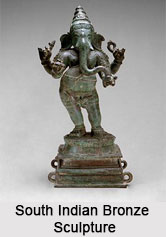 Types of South Indian Sculptures began to evolve in the early era and the early medieval era, from the time of Chalukyas, Pandya Dynasty, Chola Dynasty, and Pallava Dynasty, the art and architecture of South Indian temples and the archaeological sites of South India. Some of the popular archaeological areas and the places of historical importance are Archaeological Museum in Hampi, Arikamedu, Badami, Belur, Edakkal caves, Elephant Stables in Hampi, Halebidu, Hassan District, Kavala Caves, Mahabalipuram, Queen"s bath in Hampi, Ranganathaswamy temple, Talakad, Tulapurushandana, Vitala Temples and Warangal.
Types of South Indian Sculptures began to evolve in the early era and the early medieval era, from the time of Chalukyas, Pandya Dynasty, Chola Dynasty, and Pallava Dynasty, the art and architecture of South Indian temples and the archaeological sites of South India. Some of the popular archaeological areas and the places of historical importance are Archaeological Museum in Hampi, Arikamedu, Badami, Belur, Edakkal caves, Elephant Stables in Hampi, Halebidu, Hassan District, Kavala Caves, Mahabalipuram, Queen"s bath in Hampi, Ranganathaswamy temple, Talakad, Tulapurushandana, Vitala Temples and Warangal.
Concentration of South Indian Sculpture
The south Indian temple sculpture comprises of the sculptures of temples of Andhra Pradesh, Karnataka, Kerala and Tamil Nadu. These states have been ruled by various dynasties which include Pallavas, Chalukyas, Viajayanagar Empire, Kakatiyas, Cholas, Rashtrakutas and Gangas.
Advancement of South Indian Sculpture in India
The south Indian sculpture in different temples and archaeological sites received an added boost under the reign of the Cholas and Chalukyas. While the Vijayanagara Empire immortalised their art and sculpture on stone in Hampi, kingdoms of Chalukyas and Cholas are renowned for their massive temples, which are now in the hands of Archaeological Survey of India. These beautiful erections even today spell out the grandeur and splendour that once accompanied them.
Style of South Indian Sculpture
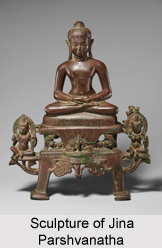 Style of South Indian Sculpture over years has undergone numerous transformations owing to the different patrons engaged in sculpturing. Both stone and bronze sculptures are prevalent in south India.
Style of South Indian Sculpture over years has undergone numerous transformations owing to the different patrons engaged in sculpturing. Both stone and bronze sculptures are prevalent in south India.
Different cultures of south India including Hinduism, Buddhism and Jainism, since ancient times, have embraced the art of sculpturing. Stone sculptures of south India mostly embellish the temple walls of different religions whereas bronze sculptures were mainly for processional images during special occasions. Different varieties of granites were used for stone sculpture. Mostly the bronze sculptures exhibit round and well finished modelling whereas those of stone have deep relief. Apart from these Iyyenar statues and horses are also popular sculptures in the villages of south India. The art has also found expression through terracotta, copper, brass, glass and white marble sculptures.
The study of Style of South Indian Sculpture unfolds fascinating and unique styles. Owing to the encouragement of the rulers of south India, a number of deft artisans had emerged in this region, who have left numerous evidences of their brilliant craftsmanship. The sculptures beautifully narrate the religious and cultural history of south India. Many of the sculptures have been well preserved till date as relics of past. However, the mastery of art can also be observed in the remains of the sculptures which have ruined over time. Keen observation can furnish stark differences in the styles of sculpture built during different eras.
Patrons of South Indian Sculpture
Chola dynasty was the major power in south India during tenth to fourteenth century. They greatly encouraged this art and had constructed several Hindu temples that showcase the most magnificent sculptures of the country. After the decline of Chola dynasty, south India was ruled by Vijayanagar Empire. The rulers of this empire were also great patrons of sculpture art. During their reign they created a number of spectacular temples, massive gateways and beautiful forts which stand as testaments of the fine art of sculpture. Sculptural remains of Vijayanagar dynasty can also be witnessed in Hampi which, in addition to stone, also houses relics of bronze sculpture. Historical facts however suggest that the art of sculpture reached its zenith during the Pallava dynasty. Satavahanas and Rashtrakutas were also great patrons of this art and sculptures from this era have also gained huge acclamations.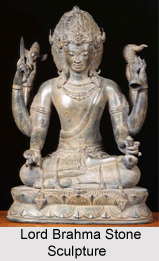
Hindu Sculptures of South India
Hindu sculpture of south India is greatly dominated by Hindu deities. Images of Lord Brahma are very common in this style of sculpturing. The constant presence of different sculptures of Brahma can be identified on temple walls of south India. The earliest images of Lord Brahma can be traced in the stone sculptures of Chola dynasty. These sculptures are exemplary of graceful and proportionate idols, carved with deep reliefs. It is said that the elegance of the sculptures renders them a princely visage rather a plump Brahmin. Images of Lord Vishnu were also an extremely common feature of south Indian sculpture. Lord Vishnu has been depicted in different forms. Bronze images of Lord Vishnu were also crafted during Vijayanagar period. The most famous avatars of Vishnu that are evident in sculptures of this region, is Lord Krishna. From the crawling figure to classical dance form, Krishna has been depicted through this art in different forms. Another popular figurine that can be observed is that of Lord Shiva. A collection of Shaiva themes are common. Classic Nataraja casts in bronze are amongst the most cherished sculptures of south India. Bronze sculpture also displays marriage icons of Shiva and Uma. The elegant and intricate sculpturing had conferred immense divinity to them.
Buddhist and Jain Sculptures of South India
A number of sculptures in south India represent Buddhist and Jain beliefs and have been carved in unique styles. The sculptures are also the portrayal of moral teachers who have earned a divine status in the religion owing to their devotion. Depiction of Buddha Sakyamuni, who played a key role in the foundation of Buddhism, is also common. Jina Parshvanatha, who was among the twenty four recognized teachers of Jains, has also been prevalently represented through these sculptures.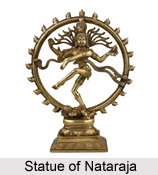 Both stone and bronze sculptures portray these images. Buddha sculptures are mostly found in Nagappattinam where Lord Buddha has been represented in varied poses. Being a popular belief of south India, portrayals of different aspects of Jainism through sculpturing prevails in the states like Tamil Nadu and Karnataka.
Both stone and bronze sculptures portray these images. Buddha sculptures are mostly found in Nagappattinam where Lord Buddha has been represented in varied poses. Being a popular belief of south India, portrayals of different aspects of Jainism through sculpturing prevails in the states like Tamil Nadu and Karnataka.
South Indian Bronze Sculpture
The south Indian Bronze Sculpture was highly influenced by Shaivism. It is because, in the early ages, Shaivasim was one of the main sects in Hindu religion. The south Indian metal sculptures were predominantly made of bronze with a large copper content. The canons of proportion were similar to that of the Buddhist sculptures of Southern part of India and the western part of India. The number of statues of bronze in early South India is concentrated in Andhra Pradesh, Telangana, Kerala, Karnataka and Tamil Nadu. There are three distinct poses employed to express the spiritual qualities of special deities of Shaiva sect. These poses included a directly frontal, static position reserved for gods in a state of complete spiritual equilibrium, poses in which the image was broken more or less violently at two or three points of its axis and a pose reserved for the great gods personifying cosmic movement or function. <
Stone Sculptures of South India
Stone sculptures of south India mostly embellish the temple walls of different religions whereas bronze sculptures were mainly for processional images during special occasions. There are different varieties of granites used for stone sculpture. Mostly the bronze sculptures exhibit round and well finished modeling, whereas those of stone have deep relief. The art has also found expression through terracotta, copper, brass, glass and white marble sculptures.
Miniature Towers in South India Sculpture
Another special feature of the south Indian temple sculpture is the miniature towers. The sculptors of Vijaynagara Empire used soapstone as it is soft and easily carved. During the period of Vijaynagara rule, the local hard granite was preferred, which was once in the hot list of Badami Chalukya Era. The use of granite reduced the density of sculptured works. As granite is prone to flaking, few pieces of individual sculptures reached the high levels of quality seen in previous centuries. In order to cover the unevenness of the stone used in sculptures, artists employed plaster to give the rough surface a smooth finish and painted it thereafter with lively colours.
Importance of Mudras in South Indian Sculpture
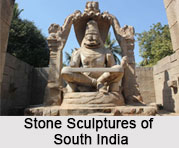 Mudras were also depicted in South Indian bronze sculptures. The mudras that depicted in South Indian art and architecture are Pranayama, Padmasana, Sukhasana and Vajrasana. There is a fixed pattern of head-dresses and jewellery that were used to drape the icons deities of the Hindu Gods and Goddess.
Mudras were also depicted in South Indian bronze sculptures. The mudras that depicted in South Indian art and architecture are Pranayama, Padmasana, Sukhasana and Vajrasana. There is a fixed pattern of head-dresses and jewellery that were used to drape the icons deities of the Hindu Gods and Goddess.
Animal Motifs in South Indian Sculpture
The South Indian history has seen a lot of great kingdoms since it`s beginning in the Sangam era to around 200 BC. Most of these rulers had contributed in making the art, architecture and sculpture of South India richer. The architects of both Hindu and Jain temples of South India had an innate desire to create animal and bird motifs in their architectural structures.
The South India had been ruled by the great dynasties such as the Cholas, Pandyas, Pallavas, Cheras, Chalukyas, Rashtrakutas, Kakatiyas, Hoysalas and the Vijayanagar Empire. Each of these dynasties had played an important role in constructing many valuable sculptures of historical importance. These sculptures made by them were very strong and beautiful that they yet exist with their magnificence. They used to carve human figures and semi-divine forms in their works. The mutual support relation of man and animals is exhibited in these motifs.
Many of these dynasties represented their tribe by using the animal symbols. For example, The Pallavas used the `Simha Stamba` at Mamallapuram, which had lions seated at the base of the pillars. Again in Kanchipuram, the restricted lions were shown frowning in a standing position on their hind legs. The lions were shown as if they were ready to jump on anyone trying to harm the temple. The head of the lion is often shown with exaggerated features such as mouth wide open with protruding upper canine teeth, spherical pointed eyes, raised ears and two large horns. The other parts of the body are shown in a more realistic way. But the body of the lion seems to be short in comparison with the head.
One of the best examples of the Pallava depicting the nagas (snakes) and elephants is the sculpture representing the `Arjuna`s self-punishment` at Mamallapuram. All these motifs feature a very important design element of the architecture of that era. There is a motif, which shows the hamsa or the swan has the skill to extract milk from a mixture of milk and water. This one acts as the symbol for the great sages, who are praised for their purity, who could distinguish the highest truth from worldly reality.
The Mukteshvara temple at Karnataka, which was built by the Chalukyas, has a wall painting that runs all around the base of the temple, on the second pedestal. Here, the makara or crocodile is shown as a graceful creature rather than a terrifying beast.
The Hoysala dynasty used animal motifs to the greatest extent. During their rule, the outer walls of the temple were embroidered with friezes of men on horses, bamsas, Puranic scenes, etc running in bands around the temple. In one of such frieze, six hundred and fifty elephants push one another in a continuous line. Elephants are believed to signify stability and probably it is due to their powerful support, the temple has survived all kinds of weather since the centuries. The temples of the Hoysala dynasty also depict the motifs in a way that the madanika or bracket figures of ladies are playing with various birds and animals. For example, in some motifs, the women are shown conversing with a parrot sitting on her right palm while another woman is shown shooing away a monkey pulling her sari, with a twig.
All these sculptures and motifs tell about the superb use of the animals and birds in the craftsmanship of the Hoysala sculptors in South India. It was believed that God Ayyanar and his soldiers used to ride the Terracotta horses at night to battle adversity and protect communities. Therefore, the Terracotta horses were shown near the God Ayyanar. So, now, the huge statues of horses are decorated colorfully at the entrance of most villages.
Most of the South Indian sculptures depict these animals very beautifully in their artwork and shows how they related art with the animals.



















